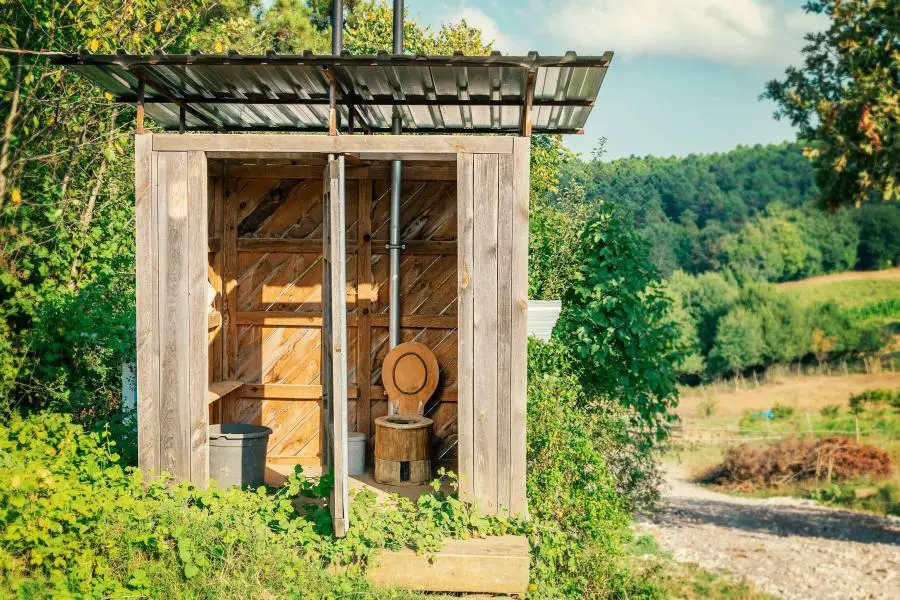Are you thinking about getting a composting toilet?
I know it’s a big decision and I wanted to help you out.
So I put together a list of the advantages and disadvantages of composting toilets.
If you’re short on time, here’s a quick summary of the points:
Pros
- eco-friendly as they save water and energy
- turn waste into something useful
- easy to use, install and maintain
- cost-effective over time
- small, compact designs
Cons
- you need to empty the toilet
- they’re not always practical
- can require electricity
- need to be properly maintained to prevent odors
- guests may not like them
Want more detail? Then keep reading…
Composting toilet pros and cons
Before we go through the pros and cons it’s important to understand two things: what a composting toilet is and how it works
A composting toilet is a waterless system that breaks down human waste and turns it into usable compost rather than flushing it away. Cool right?
How does a composting toilet work?
Composting toilets store waste in an aerated chamber directly underneath the toilet seat. Here, it’s dried out and left to turn into compost.
After a few weeks (or maybe months), your poo will be unrecognisable.
All you need to do is add in a covering material such as peat moss to give your compost a helping hand.
Most composting toilets will have some sort of system to deal with excess liquid waste (urine) as too much liquid can inhibit decomposition and cause smells. Gross!
If any odours do arise, don’t worry, the toilets ventilation system will get rid of them.
The liquid waste is either evaporated or held in a separate container for you to throw away, or use.
Did you know diluted urine can make excellent plant fertilizer?
Types of composting toilet
There are three different types of composting toilet:
- Self-contained – the composting process takes place within the toilet, you just need to add the composting materials
- Separating toilets – these toilets dry the poop so it’s ready to be composted, but you need to empty them and compost the waste yourself outside the toilet
- Central systems – these are larger systems that can handle a lot more waste, the composting takes place in a tank which is connected to the toilet
The pros and cons we discuss here apply mainly to the first two types (self contained and separating) as these are the most popular models.
Pros of composting toilets
There are many advantages of owning a composting toilet, including being eco-friendly and cost effective in the long run.
Eco-friendly as you save water and energy
Are you trying to use less water and reduce your environmental impact?
If the answer is yes, then a composting toilet is a no brainer.
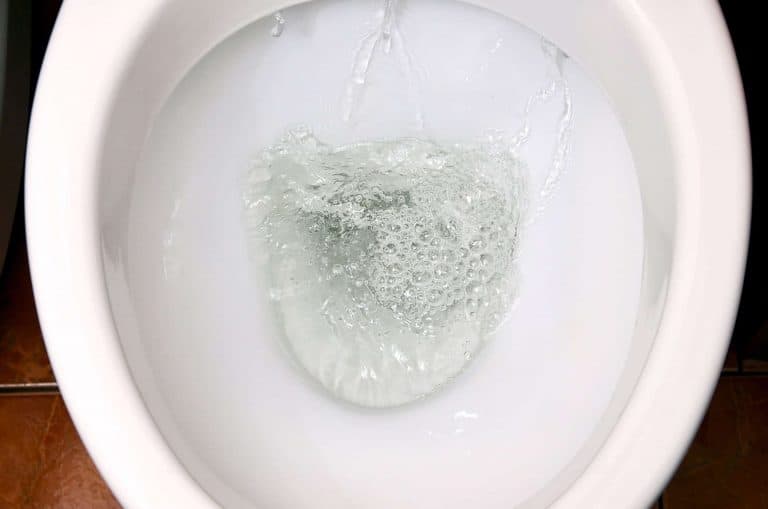
These days the average toilet uses 1.6 gallons of water per flush.
For one person this equates to an estimated 2920 gallons of water per year. That’s 37 baths flushed down the loo.
And it gets worse.
If your toilet was installed before 1994, then it could be using up to 3.5 gallons of water per flush. Enough to fill 80 bathtubs.
In comparison, composting toilets use no water. For us, this is probably one of their biggest pros.
They also use very little energy and have a minimal carbon footprint.
Normally, processing human excrement uses energy in everything from transporting the waste to treating it in dedicated treatment plants. Treating wastewater is a big drain on resources.
When you deal with the waste in-house, there’s no need for all this energy expenditure.
Turn waste into something useful
When you flush something down the toilet it’s gone forever. Trust me. That ring I flushed by accident, I never got it back.
Composting toilets save your poop from this fate and instead turn it into something useful.
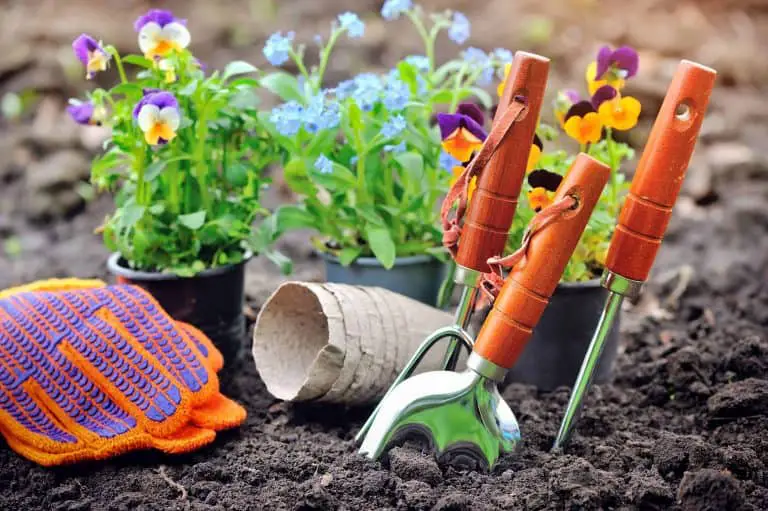
Once the feces in your toilet has completely decomposed, you can use the compost in your garden just as you would use regular compost. You can even use it as an ingredient in compost tea.
It’s full of all the good nutrients that your plants need to flourish.
The only thing you shouldn’t use the humanure on is edible plants.
Human waste can be pretty slow to compost. If you find yourself getting impatient, take a look at these tips on how to heat up your compost – hot temperatures speed the process up.
And it’s not only the solids that can be useful.
If you have a separating toilet you’ll also be able to make use of the urine. Lots of people swear by using it on their plants, just make sure to dilute it first.
Easy to use, install and maintain
Composting toilets are very easy to use.
You use them in exactly the same way as a standard toilet. Apart from guys, who have to sit down. Yes, even when it’s just a number one.
A bonus advantage for the women – the toilet seat will never be left up again.
You won’t have to give up any of your luxuries like toilet paper or bidets.
When the toilet’s ready to empty, all you need to do is lift the seat up to access the composting matter below.
Composting toilets are also incredibly easy to install.
Have you ever put together flat pack furniture? It’s easier than that. We promise.
Most people will be able to set the toilet up by themselves. There’s no need for a plumber because there’s no complicated drainage system to deal with.
If you live in an area with limited access to plumbing and sewer systems these toilets are a life saver.
Lastly, waterless toilets are low maintenance.
They’re simple in design and have almost no moving parts. Put simply there’s nothing to break. And if there’s nothing to break then there’s nothing to fix either.
Cost-effective over time
You might be surprised to see this listed as an advantage.
We known composting toilets can look expensive on the face of it, especially if you’re looking for a more premium option.
However, once you consider that all you have to pay for is the one-off purchase, they’re a very cost-effective option.
Compared to a traditional toilet they’ll save you a significant amount of money on water bills and maintenance costs.
You don’t need to worry about paying someone to come and install it for you, and there’s no need to hook it up to a septic system, which can be quite expensive.
If you did have a septic system, there’s also the ongoing cost of having someone come and empty it.
On a tight budget?
There’s always the option of building a DIY composting toilet from scratch.
It’s easy to create a makeshift version for very little money.
You’ll need:
- a large bucket (five gallons)
- a few compostable bags
- a covering material that’s good at controlling odors
Small, compact designs
If you have limited space, such as in an RV or a tiny house, then this is a big bonus.
They aren’t necessarily smaller than traditional toilets, but some people expect them to be big and bulky because of the need to store the waste.
Luckily, this isn’t the case.
A composting toilet will easily fit in a tiny bathroom. And if space is really tight, you could even install the toilet in an outhouse.
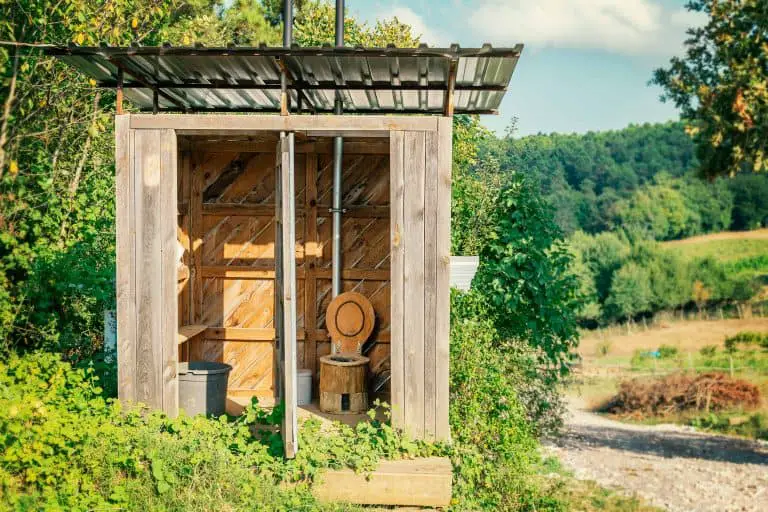
Cons of composting toilets
Waterless and composting toilets aren’t without their downsides. A lot of people can be apprehensive about emptying the toilet and the practicalities of day to day use.
Modern composting toilets have improved significantly in recent years and some even come with clever features such as an automatic cover for the solid waste bin.
You need to empty the toilet
We know the thought of having to handle human waste probably doesn’t excite anyone, but does it make you feel queasy?
If you decide to get a composting toilet, add ’empty the toilet’ to your chore list.
Most composing toilets, self contained or separating, collect the urine in a small container which you have to empty every few days.
This can be inconvenient if you’re on the road and can’t find a suitable place.
Furthermore, if you have a separating composting toilet that doesn’t actively compost the poo, you’ll have to deal with raw solid waste.
The waste should be very dry and won’t smell, but this is still too much for some people.
Sorry if we’ve made you feel queasy!
Separret has a waterless toilet with some cool features to help the squeamish amongst us out. For example, there’s a lid to cover the solid waste bucket that only opens when you sit down and automatically closes again when you stand up.
With self-contained toilets, you don’t have to worry so much about handling raw waste because it’s composted in the toilet.
However, some users have reported overflowing problems that can be messy to clean up. Yuk!
They’re not always practical
We wish everyone could have a composting toilet, but sadly that’s not the case.
Before buying one make sure to check local guidelines about composting toilets because these can differ.
They work well if you’re living in a rural setting that has plenty of outdoor space to store the compost.
But aren’t really suitable for anyone living in an apartment, or somewhere without access to a garden. For us this is one of the most significant cons.
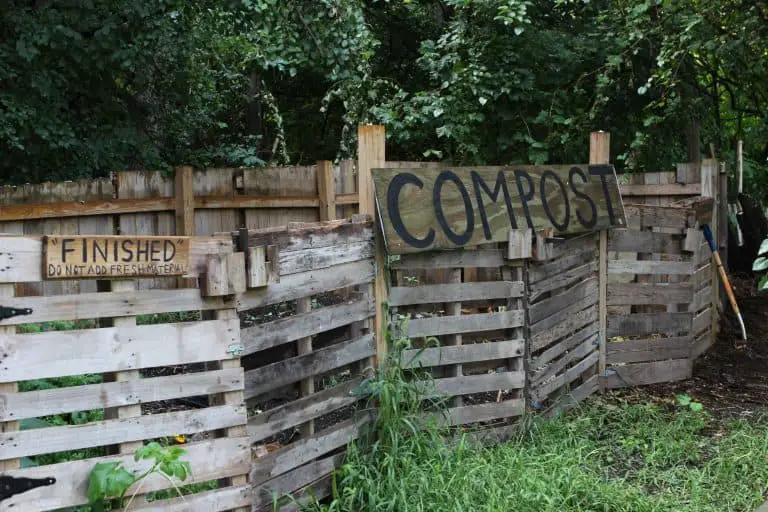
Also, think about how much use the toilet will get.
A lot of use? Then it’s worth bearing in mind that waterless toilets have limited capacities.
This usually isn’t a problem for one or two people. But if you’re a large family, then you might find that one toilet is inadequate for everyday use.
Live in a cold climate?
During the winter the composting process will be much slower (unless the toilet has a heater), so the toilets capacity will be even smaller.
Have a large family but dead set on getting a composting toilet? Why not buy two?
Can require a power source
While a traditional toilet functions without electricity, most modern composting toilets come with a ventilation system that needs a power source to run.
The ventilation system helps prevent odours, so it’s pretty important.
While the toilets only need a small amount of power (a solar-powered battery will be sufficient), if you prefer to live without any electricity, then this can be a problem.
There are options without fans that don’t require electricity.
However, these are more prone to smelling. Especially if the composting toilet is used a lot or kept in a small space.
Need to be properly maintained to prevent odours
Composting toilets are designed to control smells, but admittedly, some are better than others.
As with any toilet, you have to keep it properly maintained to keep it smelling fresh.
Finding a good covering material, such as peat moss, or coco coir will help with odor control. However, sourcing these and storing them can be problematic if you’re living on the road.
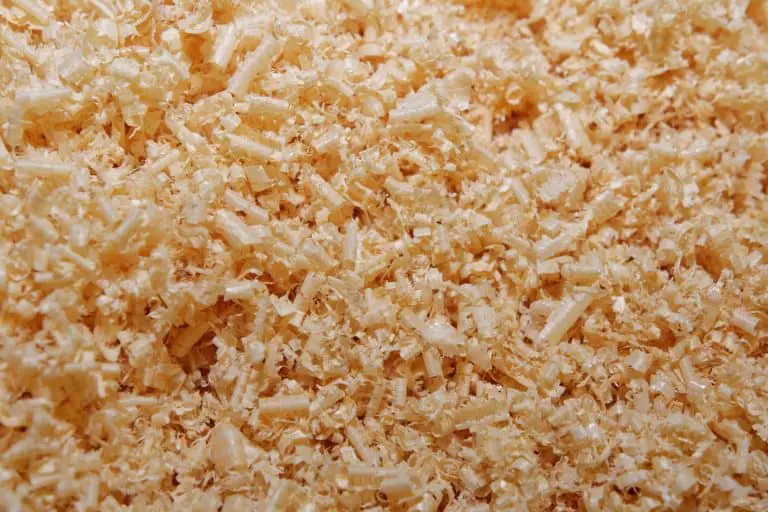
Some people recommend sawdust but we found this was a nightmare to clean up when we used it as cat litter.
It got everywhere!
Also a word of warning. If you try and empty the toilet too soon after someone has used it, it may smell.
How bad depends on what you had for dinner the night before.
Maybe stay away from spicy curries if the toilets getting full?
Guests may not like them
Composting toilets can be a strange concept for some people.
If you have regular guests at your house, then you’ll have to explain to them what the toilet is and how to use it.
This won’t be a problem for most people, but it’s something to think about.
What’s the best composting toilet?
My recommendation is nature’s head composting toilet with a spider handle design.
Now we’ve gone through the pros and cons of composting toilets let’s take a look at which is the best one to buy.
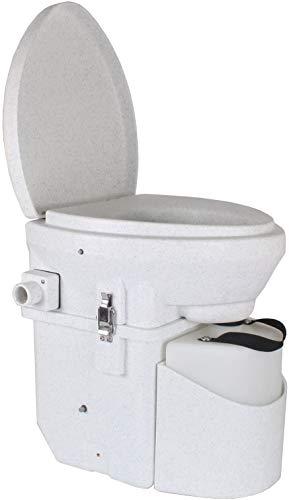
This toilet was designed by two sailors who weren’t happy with the options available to them. They designed it with the end goal in mind and this is apparent throughout its design.
It’s a self contained toilet so composts the waste within the toilet, however it separates the urine so you’ll have to empty the liquid compartment every so often.
It’s small, durable and work well to contain odours.
You’ll get about 60-80 uses out of the toilet, and you’ll know when it’s starting to get full because the churning handle will get hard to turn.
There might not be any added extras with this composting toilet, but it’s one of the best at doing the job it was made to do.
This is why it’s our top rated choice.
Summary
So there you have it, our list of composting toilet pros and cons.
Composting toilets are an environmentally friendly alternative to a traditional toilet. They’re also budget-friendly and easy to use.
We think the only real drawback are the limitations surrounding who can own a composting toilet.
But, if you live somewhere suitable then we feel the pros far outweigh the cons.
A great composting toilet is nature heads waterless toilet.
It’s well designed, reasonably priced and excellent at odour control.
